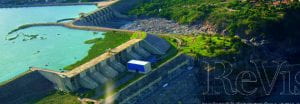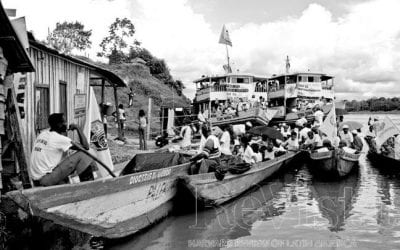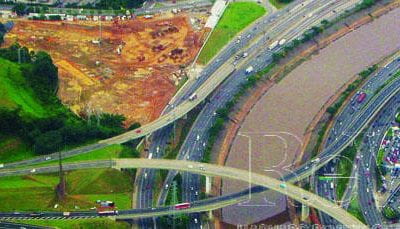Water, The Energy Sector and Climate Change in Brazil
Huge Challenges
As a Brazilian, I am very proud of the rich natural resources of my country, in particular water resources. As an engineer who had worked in the Brazilian energy sector for the last fourteen years, I am very proud of the infrastructure built over the last seventy years that has allowed the use of water resources responsibly and intelligently. But as a hydrologist and doctoral student in water resources, I’m concerned about studies that indicate alarming impacts of climate change in Brazil, particularly in the Amazon. An ongoing initiative at the Sustainable Science Program at Harvard, coordinated by Professors Paul Moorcroft and John Briscoe, is examining the long-term sustainability of agriculture and hydropower in the Amazon basin. Agriculture and hydropower in Brazil face changes in the region’s water cycle arising from land-use transformation and global climate change. But why would climate change affect the energy sector?
Brazil has developed a mixed energy supply with more than 88 percent of electricity coming from renewable, mainly hydroelectric (more than 80 percent), sources. Besides the advantage of having our power generation based predominantly on water, we have a great additional advantage: the full interconnection of our power grid system allows an exchange of electric power between different regions of the country. This exchange allows the cycles of Brazilian rivers to complement each other. For example, during periods of drought in the south region of the country, energy comes from the southeast, northeast and north of Brazil.
This energy exchange became feasible thanks to large reservoirs built along with hydropower plants over the last decades of the 20th century. There are other advantages to these large reservoirs as well. The reservoirs create a dependable water source not affected by the seasonality of the water cycle. Irrigated agriculture, transportation and tourism are benefited by the regularization of flows provided by reservoirs. In addition to large reservoirs, the Brazilian power system also has extensive transmission lines (over 100,000 kilometers extension in the end of 2010).
To ensure the security of the energy supply, correct planning and execution of the transmission system are vital. In 2001, Brazil faced severe power rationing, which cut 20 percent of its power supply in all regions. Two factors were behind these power cuts: the lack of expansion of generation and transmission, and severe drought in the Northeast and Southeast. At that time, the Brazilian energy model had left the balance between supply and demand to private enterprise and free competition. It became clear that this model no longer worked.
In 2004, the Federal government laid the foundations for the New Model for the Electricity Sector. In institutional terms, this established several areas of responsibility: (1) the Energy Research Company (EPE) in charge of long-term planning in the electric sector; (2) the Electric Sector Monitoring Committee (CMSE) to continuously assess the security of electricity supply; and (3) the Chamber for the Commercialization of Electric Energy (CCEE) to deal with sales of electricity in the interconnected system. The New Model for the Electricity Sector seeks to ensure security of electricity supply, to keep prices moderate and to promote social inclusion in the Brazilian electricity sector, in particular through universal supply programs. As a result, the Brazilian electricity system is strongly integrated with the reliable large reservoirs and transmission lines across the country (see figure.)
There are dozens of both public and private companies operating in the generation and transmission sector in Brazil. The National Power System Operator (ONS) is responsible for command generation from all sources of energy and also operates the entire transmission system. This ensures coordination and operation at the lowest possible cost.
Considering the growth of the Brazilian economy, and even taking into account energy conservation measures, EPE studies indicate that Brazil needs to add approximately 6,500 MW of new installed capacity (equivalent to half the generation capacity of the Itaipu plant) each year.
This means that Brazil faces the challenge of tapping its unused hydroelectric potential, 60 percent of which located in the Amazon. It is thus concerned about the environmentally sustainable way to use that potential and has worked hard to develop manuals and procedures explicitly taking into account the social and environmental costs in determining the costs of power plants. Most new plants are planned as run-of-the-river plants, but this means that they are left without effective capacity to store water. In other words, they have no regulating capacity. This feature is detrimental to the electrical system, since during periods of low flow in rivers, it will still have to rely on existing reservoirs and generated energy from fossil fuels.
There are also societal costs to the reduced storage capacity of the new plants. For example, without regulation, some crops could not be developed because during drought periods there won’t be water for irrigation. Likewise the reservoir can provide reliability for the supply system of a city. Stored water contributes to the development of various sectors such as agriculture and tourism and ensures the water supply for the population.
Climate Change and Hydropower
Hydropower plants without regularization of reservoirs are more dependent on natural flows. Therefore, if we continue to expand their presence in the electricity sector, we must also account for more drastic changes in rainfall, which would affect streamflow patterns in Brazilian rivers. This is a great challenge for planners in various sectors and for the operation of the electricity system.
For example, a private agent who has an interest in building a hydropower plant that will have its concession auctioned by the Brazilian government will be interested in the impacts of these changed runoff patterns on their construction costs. Climate change will affect rainfall patterns, influencing maximum and minimum values of streamflow. Thus the dimensions of strategic parts of the plan (spillway, coffer-dam, water intake) must be adjusted.
Power System Operators will need to know the impact variations in rainfall will have on streamflow seasonality and maximum streamflows. Operation schemes and energy market pricing are currently based on optimization models that assume that streamflow amounts remain stationary. These models consider the patterns of past flows to generate future scenarios, but they don’t generally account for changing flow patterns in future scenarios. Of course, the models used by ONS are only an aid in the overall decision-making process. But in the future, models will have to account for more irregular changes in streamflows to make predictions, as these models are weighed price signals that reflect the data from the model results.
On the other hand, the impact of climate change also poses a great challenge to energy planners. Today, when long-term expansion plans are made, different scenarios of energy demand are analyzed that correspond to various scenarios of economic growth. Currently, the planning models assume stationary streamflows. But it will be important in the future to analyze different patterns of flow to project how best to ensure supply in different scenarios of demand.
Therefore, continuing to study the impacts of climate change on Brazilian rivers is essential to the Brazilian energy sector. Analyzing the impacts of different patterns of rainfall and changes in land use is fundamental to estimating streamflow sequences in the future. It is also important that the results be used as an input to new policies and decisions.
In the Sustainable Science Program initiative at the Kennedy School, we are using data from the coupled biosphere-atmosphere simulation, which provides us with projections of regional climate and land use change, as input for hydrologic models that provide projections of runoff. We will assess the hydropower implications of these runoff projections. One interesting dimension of this project is that there is realism in the representation of agricultural landscapes within the terrestrial biosphere model—that is, we will have a very accurate idea of changes resulting from agricultural patterns.
We also intend to design a Brazilian approach to make our results relevant to policy makers. We will meet with both Brazilian policy makers and technical experts to ensure that we answer questions in a more specific, applicable way. In May 2013, we will hold a workshop in Brazil for the presentation of our results and discussion of the subject. We hope to help the energy sector in Brazil—already highly capable—to develop sustainably in the face of climate change.
Angela Livino is a Doctoral Research Fellow in the Sustainability Science Program at the Harvard Kennedy School and a Fulbright Fellow. She is doing her PhD at the Civil Engineering Program at the Federal University of Rio de Janeiro. She is a senior technical consultant on energy supply at EPE in Brazil (currently licensed).
Related Articles
Al Son Del Río
English + Español
Wending our way down the Atrato River in Colombia’s Chocó region, we finally reach the town of Puné. It is a fickle June afternoon, one of those humid tropical afternoons when the sun and water alternate in sudden torrential rains. “The river is everything to us,” …
Water: The Last Word
A man was shot and killed in a dispute in June 2010 over a water connection in San Juan Cancuc, Chiapas, Mexico. A Zapatista settlement coexists, if uneasily, on the edge of the municipality. Residents of the nearby community of El Pozo had threatened to shut off Zapatistas water connection. A confrontation ensued, shots followed, with one fatality and nine wounded. …
Water-Friendly Cities?
The world just turned urban. For the first time in human history, urban citizens make up more than half the world’s population, the 2006/2007 UN-Habitat State of the World’s Cities Report tells us. In the last century, Europe and the Americas experienced intense urban growth. Today this is the reality for Asia and Africa….






